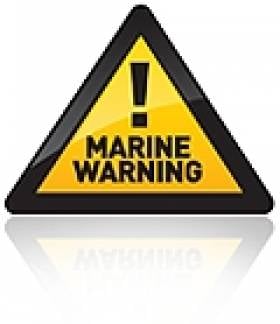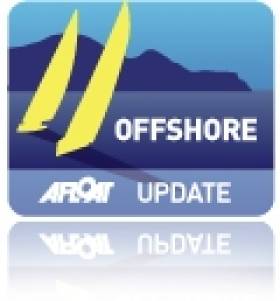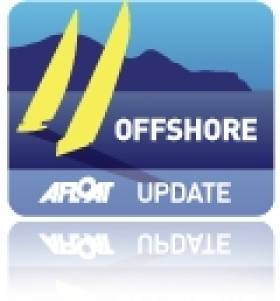Displaying items by tag: Offshore
NI Calls for Voluntary Ban on Offshore Salmon Fishing
#ANGLING - Northern Ireland's Department of Culture, Arts and Leisure (DCAL) has called on anglers to help protect the North's wild salmon, following new research that shows a significant drop in their numbers.
Fisheries Minister Carál Ní Chuilín told BBC News: "The continued commercial exploitation of wild Atlantic salmon and killing of salmon caught by rod and line in the DCAL jurisdiction is currently untenable."
Annual monitoring of Northern Ireland's salmon rivers has shown a failure to reach targets most years since 2002. The survival rate of salmon in the marine phases has in some cases dropped to as little as 5%.
DCAL has now urged offshore salmon anglers and fishermen to forego applying for 2012 licences, to give time to consider options for the future of salmon fishing.
BBC News has more on the story HERE.
Marine Notice: Hydrographic Survey in Irish Sea
#MARINE WARNING - The latest Marine Notice from the DTTAS advises all seafarers in the Irish Sea between north Dublin and north Wales to give a wide berth to the hydrographic and oceanographic survey operation in the area this week.
The SV Bibby Tethra (callsign 2EGF8) commenced survey operations yesterday (Monday 16 January) from offshore at North Beach in Rush to approximately 16 miles offshore north of Anglesey. The survey is scheduled for seven days, subject to weather delays.
The vessel will operate on a 24-hour basis, displaying appropriate day shapes and lights during survey operations, and will transmit an AIS signal. The vessel will be keeping a listening watch on VHF Channel 16 at all times during the operations.
Survey operations will involve towing survey equipment up to 100m astern of the vessel along pre-defined survey lines, which will restrict the vessel’s ability to manoeuvre.
Details of the survey area are included in a PDF of Marine Notice No 2 of 2012, which is available to read or download HERE.
World Speed Record for Thompson
#julesvernetrophy – As the only British crew member on-board, Brian Thompson, today clocked up two major records as the maxi trimaran, Banque Populaire V, crossed the Jules Verne Trophy finish line near Brest, France this evening.
Thompson is part of the crew that has just smashed the world speed record for a lap of the planet on-board a yacht and has simultaneously become the first Briton to circumnavigate the globe non-stop for a fourth time. Skippered by Frenchman Loïck Peyron with a crew of 13, Banque Populaire V, beat the existing record set by Groupama 3 by over two and a half days when they crossed the finish at 22hrs 14 minutes 35 seconds GMT Friday 6th January. The Banque Populaire V crew sailed non-stop around the world in an incredible 45 days 13 hrs 42 minutes and 53 seconds.
{youtube}D0GNiPOVHVA{/youtube}
Having spent over six weeks at sea, the crew were thrilled to see a flotilla of boats and crowds on the dock ready to welcome them home and are looking forward to celebrating their success with friends and family.
A triumphant Thompson said:
"This has been an incredible trip around the planet, almost a dream ride. And that is because of the quality of the boat, of the preparation and most of all to the incredible crew on board. I am very fortunate to have sailed with Loïck, the best all round multihull sailor there is, and the rest of the team that are so talented, industrious, dedicated, fun and welcoming to an English guy with schoolboy French! To achieve my dream of finally holding the Trophée Jules Verne, and of setting the most prestigious record in sailing for the second time, feels absolutely fantastic. At the same time, to become the first Briton to sail around the world non-stop 4 times, is just amazing and feels very special"
Despite having just completed an epic voyage, Thompson is already looking to the future as he hopes to be on the start line of the Vendée Globe in November 2012. Commenting on his next goal he said:
"I have so enjoyed sailing round the world on Banque Populaire V, a trip on fast forward. And the whole way around I have been thinking about every detail on how to do another solo lap of the planet - faster, safer and more environmentally efficient than ever before. What better place to test that experience, than in the Vendee Globe 2012?"
In addition to the overall speed record, the crew aboard Banque Populaire V have already broken two other world records on this amazing sprint around the globe; one across the Indian Ocean* and one from equator to equator**. Last year this formidable yacht set two further world speed records; the first for sailing around Britain and Ireland in June 2011 and the second when the crew were the fastest the classic Fastnet course in August 2011. Although this latest world speed record relates specifically to a yacht, the lap of the planet has actually been completed faster than any other vessel ever, be that under power or sail.
Gordon Maguire Lifts Sydney-Hobart Trophy
#SYDNEYHOBART – Dublin Sailor Gordon Maguire won the Rolex Sydney-Hobart Race, a high point in his career as a leading international professional sailor based in Australia writes W M Nixon in the Irish Independent.
Twenty years ago, the young Howth helmsman was one of the key players in the Irish team which won the Southern Cross Trophy, the international offshore series which culminated in the Hobart Race.
For someone with Maguire's remarkable talents, Australia offered the perfect arena and base, and he increasingly focused on the active scene down under. But he also continues to sail worldwide, his most recent high profile appearance in Ireland being three years ago when he was lead helm on Mike Slade's 100ft Leopard establishing the course record in the Round Ireland Race.
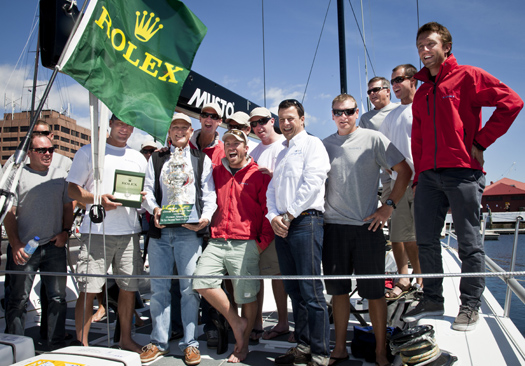
The winning Loki crew included Howth's Gordon Maguire. Photo: Daniel Forster/Rolex
Since then, his career path has been as sailing master with Stephen Ainsworth's Australian team. Ainsworth acquired some note in Europe back in 2007 when his mini-maxi Loki, powering along in the stormiest Middle Sea Race yet experienced, broke the rudder and became a total loss on the northwest coast of Sicily. That iron shore would rank high on any world listing of least desirable places to be shipwrecked, and some advanced yacht racing equipment subsequently turned up in unlikely mountain sales.
But at least no-one was hurt. And a new Loki, a 63ft Reichel Pugh design, was already on the drawing board. To get the best from the new boat, Ainsworth and his ace navigator Michael Bellingham signed Gordon Maguire (48) onto what became a dream team. Since 2008, Loki has won just about everything of significance in the Australian eastern seaboard offshore racing scene except the annual thrash to Hobart, which Ainsworth has been trying to win for more than a dozen years.

The winning mini-Maxi Loki. Photo: Daniel Forster/Rolex
The 628-mile classic – staged annually since 1945 – can be a tricky one. You go like the hammers of hell on rough ocean for upwards of 550 miles, and then the final approach to Hobart up the narrowing 60-mile ria of the Derwent River sees the winds all over the place, and often non-existent at night.
The new Loki (named for the Norse god of mischief and trickery) invariably finished among the leaders, but then saw her corrected time win for the Tattersall's Cup – Australia's premier offshore trophy – being snatched away by some smaller boat which came creaming up the Derwent on the afternoon breeze.
But Ainsworth and Maguire have been very close to the cup for the last two years, and this year they struck gold. It was the turn of the smaller boats to be becalmed in the small hours. After hours of the clock ticking painfully slow, Loki was declared winner of the Tattersall's Cup. The biggest box of all had been firmly ticked in gold.
Yachts Prepare to Chase Sydney-Hobart Race Record
#OFFSHORE – Over its sixty-seven year history, the race record at the Rolex Sydney Hobart Yacht Race has only been broken ten times, an average of once every six and a half years. Given that the current fastest elapsed time of one day, eighteen hours, forty minutes and ten seconds was set in 2005, statistics suggest that the feat is due to be surpassed again.
That time was set by Bob Oatley's Wild Oats XI, a 100-ft Maxi yacht that has come to dominate the Rolex Sydney Hobart, claiming five of the last six line honours titles. She is the standout favourite for this year's title. The yacht, launched in 2005, has undergone regular and expensive enhancements throughout the past six years, yet has been unable to improve upon her record. Wild Oats XI finished within two hours of her record in 2008, the closest she has come, whilst the time set during her most recent victory saw her finish over 13 hours shy. Proof that in offshore racing, the elements dictate almost everything.
As is form in ocean sailing, the fastest time was broken frequently in the race's infant years. The inaugural winner was Captain John Illingworth's 35-ft Bermudan Cutter Rani, who finished, to her surprise, 17 hours ahead of second-placed Winston Churchill. The event evolved quickly, interest grew and entry numbers rose. There were four records set in the first six years alone. Claude Plowman's Morna achieved the feat twice. Her first triumph arrived in 1946 when the William Fife-designed 65-footer led the race from start to finish, finishing the 628-nautical mile challenge bereft of her main sail. Eerily similar to Wild Oats XI's famous finish in 2005 when the crew cruised through the last stretch of the Derwent River with only their headsail in tact. The crew reported arriving to a hospitable welcome in Hobart, having the sensation that they had been granted freedom of the city.
Two years later and with a crew of 16, Morna claimed her third consecutive line honours win, almost smashing her own record by a day, courtesy of champagne sailing conditions. She became the first boat in the race's four-year history to complete the race before the arrival of the New Year. Plowman received a knighthood just hours after crossing the finish line. Under the guise of Kurrewa IV, and new ownership, Morna was to take four subsequent line honours titles and one further race record.
After Margaret Rintoul set a benchmark of four days, two hours and twenty-nine minutes in 1951, the four-day barrier was broken in 1957 by the aforementioned Kurrewa IV, now owned by the Livingstone brothers. Ever since the end of the 1950s, surpassing the fastest time has become a much more irregular feat. In 1962, New Yorker Sumner A. 'Huey' Long steered one of two American record-breakers helming his lovingly-maintained 57-ft Ondine home in just under three days and four hours. This was the first of Long's three line honours triumphs at the event, the record attempt achieved following a tight battle with Astor in the Derwent River.
Ondine's record stood for an imperious nine years, when the 73-ft Helsal, owned by Dr Tony Fisher, the only purely Australian crewed and built race record holder, shaved barely two hours off the target. She marked a trend: at the top end of the fleet, the faster boats were getting bigger. A ferro-cement yacht, Helsal was nicknamed the Flying Footpath. Her victory is seen as something of a miracle given the problems encountered in rendering her race-ready and that her array of sails was relatively sparse and out-dated compared to her rivals.
The second United States success was achieved by Kialoa III in 1975. She shattered Helsal's 1973 time by just under eleven hours, the Sparkman & Stephens 79–footer taking advantage of ideal conditions and a fantastically consistent race, sailing at 15-20 knots throughout the second day. Overall, she averaged a speed of over 10 knots, not outstanding when compared to today's Maxis, but significant at the time. Californian Jim Kilroy had already helmed his Kialoa II to line honours four years earlier. When the crew arrived in Hobart at 03:36, the sky was so dark that the shoreline was barely visible. Kialoa III dominated Maxi racing during the mid-1970s – she was also the fastest on the water in the Transatlantic and Fastnet Races in 1975. Quite a year.
Where others had tried and failed, Hasso Plattner's 80-ft Reichel-Pugh Morning Glory succeeded, breaking Kialoa III's record by a meagre 29 minutes in 1996. It is almost startling that in an era of outstanding developments in the design and construction of yachts, and the onboard apparatus, that the record remained unsurpassed for so long. Indeed: almost a minute for every year that had passed. The 1996 race was renowned for a particularly harsh start with winds hitting 40 knots and steep sea state building up. Morning Glory enjoyed a stretch of cruising at 30 knots before the gusts abated near Tasman Island. But for the softening of conditions, she would have beaten the record by a much greater margin.
Following the tragic events of 1998, when six sailors lost their lives in harrowing conditions, 1999's race was characterised by the arrival of the forecast strong gusts and record-breaking conditions once more. The Volvo 60 Nokia sliced a massive 18 hours off the short-lived1996 figure, cruising down the South Wales Coast and into the Bass Strait, in winds of 30-40 knots. The race was a spinnaker extravaganza. The water-ballasted Nokia, led by Stefan Myralf and Michael Spies, one of an incredible seventeen yachts to break the record that year!
In 2005, the most recent race record went to Oatley's Wild Oats XI, another Reichel-Pugh design. Led by skipper Mark Richards, Wild Oats' commanding lead over the pack, set with an average speed of 15 knots, gave her an overall handicap win ensuring she was the first boat since the inaugural year to claim all three of the race's main prizes: line honours, race record and Tattersall's Cup. Wild Oats XI starts as favourite this year to beat her own record. Only one yacht has ever achieved that. Has the time come?
Round Ireland Yacht Race 2012 Takes Shape
#SAILING–Wicklow Sailing Club's Round Ireland Yacht Race departs from Wicklow Bay at 12 noon on Sunday 24th June 2012, leaving Ireland and all its islands to starboard.
2012 mark's the 32nd anniversary of Ireland's premier off-shore sailing event, organised by Wicklow Sailing Club in association with Royal Ocean Racing Club (RORC).
It is the longest race in the Royal Ocean Racing Club calendar, comparable to similar Offshore races such as the Fastnet, Malta Middle Sea, Sydney-Hobart and China Sea races.
The first race took place in 1980 with only thirteen boats. Since then, held biennially, the fleet has grown steadily, and up to 60 yachts have competed in some past editions of the race.
The backbone for the 2008 race was Tonnerre de Breskens III, owned by Dutchman Piet Vroon. The crew arrived in Wicklow with a brace of RORC victories, leading RORC's offshore table, and went into the race as favourites. The first twist in Tonnerre's plot came before the starter's gun, when Vroon ended up in hospital, from where he would follow the race as his crew sailed on without him.
However, that would be the only bump in their road. Tonnerre led from start to finish, both on the water and on handicap. Vroon's crew brought home the trophy for their ailing skipper in the race's happy ending.
Sailing around Ireland poses many challenges for boats and crew, with open ocean on the south and west coasts, tidal challenges on north and east coasts apart from all the off lying rocks and sandbanks to keep navigators on their toes and not forgetting the vagaries of the Atlantic weather systems.
This is very much a sailors race but armchair spectators can follow the race on their computers, thanks to our modern race tracker technology.
A Round Ireland Sail Fest (Thur 21 - Sun 24 June) will complement the race preparations and add a welcome level of fun and entertainment for all coming down to Wicklow for the Race start.
ROUND IRELAND YACHT RACE 2012 on SUNDAY 24TH JUNE
NOTICE OF RACE
ORGANISATION
The Race is organised by Wicklow Sailing Club in association with the Royal Ocean Racing Club.
CONDITIONS The race will be sailed under the Racing Rules of Sailing 2009-2012, the ISAF Offshore Special Regulations, the Irish Sailing Association (ISA) and RORC Prescriptions and amendments and the additions detailed below:
1. This Notice of Race, the Entry Form and the Sailing Instructions.
2. The Race is ISAF Offshore Special Regulations Category 2.
3. IRC Rules Parts A, B, & C – 2012 Rules.
In the event of conflict the Sailing Instructions shall prevail.
START The start will be at Wicklow on Sunday, 24th June 2012.
COURSE Leave Ireland and all its islands excluding Rockall to starboard. The distance is approximately 704 nm.
ENTRIES To: Wicklow Sailing Club, C/o. Dennis Noonan, "Dunmore", Sea Road, Newcastle, Co. Wicklow. The closing date for entries is 8th June 2012. Exceptionally late entries may be accepted, for which there will be a late entry fee. Entries will be from IRC (Endorsed) rated yachts of LOA 9.15m/30 feet and over, with a minimum SSS of 28 or STIX of 32 combined with an AVS minimum of 130-0.002 x M (where M is minimum sailing weight in kg). STIX and AVS data is required for boats with a series date of 1995 and later.
ENTRY FEE LOA: 30-39.9 feet €400 40-49.9 feet €450 50-59.9 feet €500 60 feet and over €550.
LATE ENTRY Late entries will be subject to the relevant fee above +50%. No entry will be accepted after Thursday, 22nd June 2012.
CANCELLATION POLICY Cancellations can be accepted either:
(1) before the closing date, when a refund minus €50 may be claimed or
(2) between the closing date and the start, when 50% of the fee may be claimed.
ENTRY The Race Committee reserves the right to decline an entry.
ENTRY LIMIT The number of starters shall not exceed 75.
CLASSES Racing will take place under IRC. Classes will be allocated according to the number and type of entry. Classes for classic and one design yachts will be subject to the number of entries. Yachts may enter as a team, but RRS Appendix D, Team Racing Rules, will not apply. Details will be provided on application.
Classes will be as follows:
IRC Class CK – 0.850 and greater
IRC Class Z - 1.276 and greater Class 5 – Cruisers, Hull factor 7.5 or less
IRC Class 1 - 1.275 – 1.101 Class 6 – Classics Class (pre 1987)
IRC Class 2 - 1.100 – 1.051 Class 7 – Sigma 38 to Class Rules
IRC Class 3 - 1.050 – 1.007 Class 8 – Two-handed Class
IRC Class 4 – 1.006 - 0.850 Class 9 – TBA
The Race Committee reserves the right to alter the rules and conditions of the race at any time. Changes will be posted on the WSC website at www.wicklowsailingclub.com. Yachts whose entries have been accepted will be advised directly.
EXPERIENCE QUALIFICATION
The Round Ireland Yacht Race is not a race for novices. Every crew member must have experience of sailing a yacht offshore and be prepared to encounter heavy weather. Competitors may be required to provide evidence of offshore experience.
The skipper and at least half the crew must have completed, in the yacht in which they will race the Round Ireland Race, in the 13 months preceding the start, either:-
1. 300 miles of offshore racing * or
2. Non-stop passage of at least 300 miles.
3. Other qualifications similar to 2. above to be proposed to and agreed by WSC/RORC by 31st May 2012.
* To qualify as offshore racing a race must be at least 75 miles duration and include at least one night at sea.
TRAINING It is the skipper's responsibility to ensure that the following criteria are met and that a certificate or letter of attendance from an establishment recognised by the ISA/RORC should be provided on completion of the following:
1. At least 30% of the crew, including the Skipper, shall have undertaken training to Section 6, (Appendix G) of the ISAF Offshore Special Regulations.
2. In the case of two-handed entries, both crew members must complete training to Section 6, (Appendix G) of the ISAF Offshore Special Regulations.
3. In addition at least one member of the crew shall hold a current Senior First Aid Certificate or equivalent (in accordance with OSR 6.05.2) and should be familiar with the management of medical emergencies that may occur at sea, including hypothermia, and radio communications operations for obtaining medical advice by radio.
4. The above training must have taken place after January 2007. Copies of these certificates should be lodged with WSC prior to the start of the race.
CREW LIST A full crew list with names, addresses and telephone numbers of competitors and their next of kin to be lodged with the Race Office on Registration at Wicklow Sailing Club.
INSPECTIONS Yachts shall assemble at Wicklow Harbour no later than 1200 hours on Friday, 22nd June 2012 for Special Regulations inspections. Deep draught yachts may be inspected at Dun Laoghaire, by agreement with the race organisers.
RORC SPECIAL REGULATIONS CHECK-LIST
Each entrant must complete an ISAF Offshore Special Regulations Check List. The completed Check List must be submitted to Wicklow Sailing Club prior to the start of the race and a copy must also be retained onboard the yacht.
ADVERTISING Advertising will be acceptable under conditions to be provided on application. Yachts may carry advertising according to the Racing Rules of Sailing and their class or rating authority. Yachts will be required to fly a race flag and may be required to apply a race sticker to each side of the hull.
TRACKING It will be mandatory for yachts to carry a Tracker Unit for the duration of the race. A refundable deposit, which may be set against a credit card, may be required.
AIS TRANSPONDER All yachts must be equipped with an operational AIS Transponder, which must be switched on and transmitting and receiving for the entire duration of the race.
TIDES Wicklow Harbour, Sunday 24th June 2012. Times are local and are approximate.
HW - 1432hrs
RATING CERTIFICATES
All competitors must apply to the RORC Rating Office as early as possible prior to the race, in order to obtain their current Endorsed Certificates in good time. Please note, STIX and AVS data is required for boats with a series date of 1995 and later. The cut-off date for amended Rating Certificates shall be Thursday the 21st June 2012.
PUBLICITY Entrants should include, with their entry, two recent photographs of the yacht for the programme and for publicity purposes.
Matt Davis is September's Sailor of the Month
The welcome revival of the offshore racing programme in the Irish Sea has been steered by Peter Ryan of the National Yacht Club in Dun Laoghaire, but without the enthusiastic crew like the Skerries squad, it just wouldn't happen.
Apart from the continuous effort of keeping a frontline offshore racer and all her equipment in sound working order, the demands on personnel for time in this crowded era can be quite exceptional. The logistics are formidable, as the regular cross channel ISORA programme is based on a willingness to alternate between starting points on the Welsh and Irish coast.
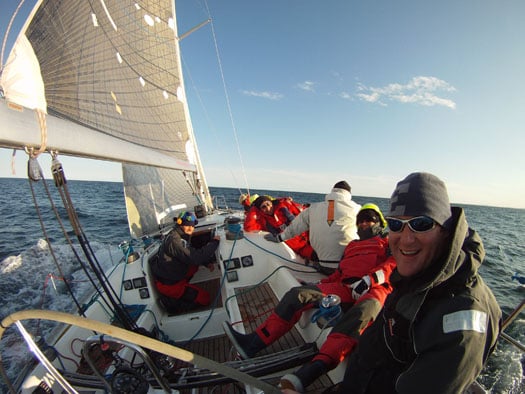
Matt Davis and crew on board Raging Bull in one of this year's ISORA races. Photo: Brian Carlin
For boats heading for an away start, it often involves an overnight passage beforehand. In the case of Raging Bull, all starts are away events, as the programme does not as yet take in Skerries. But we can hope that this will change in the future, as the nucleus of a Fingal offshore racing group develops around the Davis success.
With the summer of 2011's uneven weather, Raging Bull's crew had to be fit and ready to take full advantage of their boat's proven ability in rugged weather, while at the same time managing to turn in a respectable performance in light airs.
For the first time, the biennial Dun Laoghaire-Dingle race was recognized as an ISORA event, and Davis and his crew revelled in it. For much of the race they were the only boat mounting a significant challenge to the pace setter, Martin Breen's Reflex 38 Galway Harbour. Though the Skerries boat had to be content with the runner-up slot to the Galway boat in Dingle, they were first of all the ISORA participants, a top score which stood well to them when they continued with the Irish Sea programme right up until mid-September. Despite the limited size of the harbour, the maritime spirit of Skerries is manifesting itself in many areas of sailing, and Matt Davis's achievement is typical of the special Fingal fervour.
More on Matt's 2011 victory in Autumn Afloat magazine out next week!More ISORA News here
Ireland Risks Missing Out On Renewable Energy Benefits
Ireland must do more to develop its port and shipping services or risk missing out on the benefits of the growning renewable energy sector.
That was the message from a new analysis compiled by the Sustainable Energy Authority of Ireland and the Irish Maritime Development Office, as reported by Renewable Energy Magazine.
The current lack of supply services and equipment for renewables in Irish ports could threaten the country's promise in the fields of offshore wind, tidal and wave energy, the report states.
It is estimated that the total value of such renewable energy sectors could be as much as €16 billion.
The east coast has been identified as the best location for offshore wind and tidal projects, while the south and west coasts were best for wave power and wind farms.
“We now need to look at the investment in infrastructure required if we are to properly capitalise on the current opportunities in this area," said the report.
Renewable Energy Magazine has more on the story HERE.
Round Ireland Yacht Race 2012 Starts from Wicklow on Sunday, June 24th
Irish Offshore Sailing Makes Success of Debut Season
Irish Offshore Sailing, a new yacht training centre based in Dun Laoghaire, Co. Dublin is now launching its autumn winter calendar, having had a very busy first season, despite the current economic climate.
The school is an RYA and ISA recognised yacht training centre and was set up by Corkman Rónán Ó Siochrú in January 2011. The school runs liveaboard sailing courses onboard a 2002 Jeanneau Sunfast 37 called "Desert Star".
Sailing school Principal, Ronan O Siochru attributes much of the schools success to date to holding onto a set of core values throughout each course: A commitment to professional, affordable sail training in a 'warm friendly Irish atmosphere'. "We have come into the market under no illusion as to the difficulties in the tourism and leisure sector in a recession, but we have priced our courses in a way that reflects realistically what people can afford to pay for a sailing course.
The most important key to our success, has been a driven campaign to bridge the gap between the large number of people who have never set foot on a sailing boat, and a liveaboard sailing course! We offer evening and afternoon 2 and a half hour sails at €30 per person on the days when the yacht is not working on a practical course. This has worked extremely well for us in getting clients to take that leap of faith in booking onto a weekend liveaboard sailing course, and in spreading the word that we are a new training centre and are here to stay!
I have always had a personal commitment, to help break down this notion that sailing is a sport for the elite, having spent two years living in France, I saw how the French promote sailing in their country in the same way the GAA promote hurling and football."
Irish Offshore Sailing also offer sailing courses through Irish and French. This is a niche in the market and is certainly likely to take off over the coming year. Despite running a few very successful courses, it has had to sit on the back burner this summer, due to the business of the summer season and a lack of time to generate an effective marketing campaign. Irish Offshore Sailing are also looking forward to next season in getting an offshore racing campaign off the ground.
O' Siochru skippered a Sunfast 37 in the Round Ireland Yacht Race to a 23rd place overall with a crew of novice sailors.
When asked, how do you handle skippering a yacht offshore with the kite up in the dark with a bunch of beginner sailors he smiles......" its amazing what yacht crews can do when they just do some training, and iron out problems with each manoeuvre!" "We come across quite a lot of sailors in this country who become so eager to be boat owners that they miss out on that important learning process of being onboard yachts with experienced sailors to learn from. It was amazing even during the boom, how some people could fork out over €100,000 for a yacht and yet, be unwilling to part with €650 to learn how to use it!
The height of the summer season is starting to come to an end, but it looks like Irish Offshore Sailing has become established as a sailing school on the East Coast, with bookings filled into the end of October and over 1,000 hits per month on their website.
"I cannot believe it has worked out so well for us, I sailed Desert Star into Dun Laoghaire on the 22nd of April, maxed out on all credit, without a penny in the bank, but with a lovely yacht ready for work, a good website and a burning ambition to see it succeed...... and I think we have done okay! Most importantly, I've made a job for myself that I like.... I love sailing, I like working outdoors, I love teaching and (despite its headaches) I like working for myself!



























